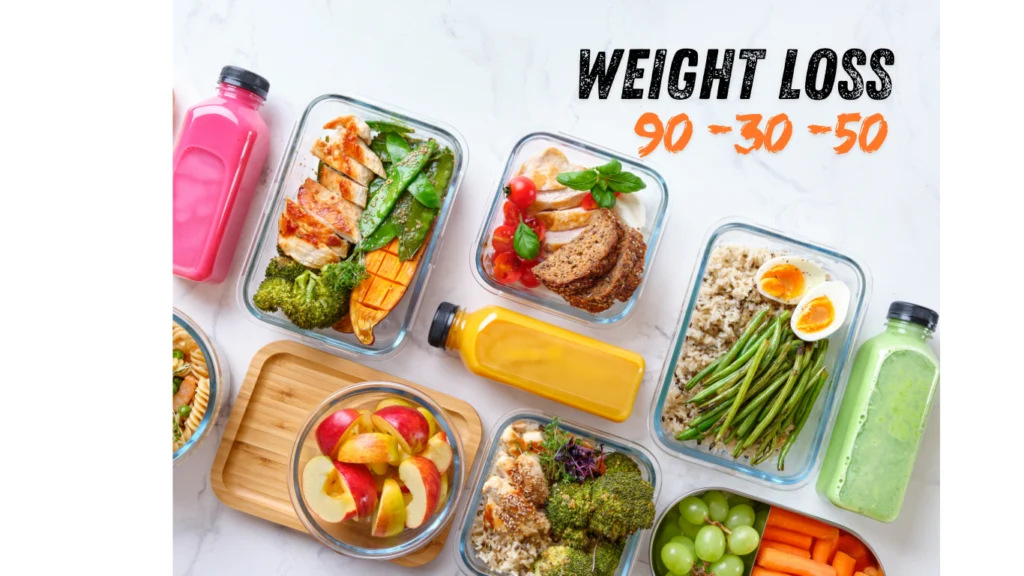The Best Fluffy Pancakes recipe you will fall in love with. Full of tips and tricks to help you make the best pancakes.
90-30-50 Meal Plan: A Proven Blueprint for Effective Weight Loss

Table of Contents
Introduction To 90 30 50 diet plan
Weight loss can often feel like a maze—with so many paths to take and so many different approaches. Understanding how to create a suitable plan is crucial for success. One effective method of achieving your weight loss goals is meal planning; it not only helps you track what you eat but also encourages healthier choices.
Enter the 9030-50 meal plan—a simple formula that breaks down your meals into nutrient-dense options that help you eat smarter without depriving yourself. This guide will explore how to leverage this meal plan for effective weight loss.
1. Understanding the 90 30 50 diet plan Concept
1.1 Breakdown of the Meal Plan Ratios
The 90-30-50 meal plan revolves around three essential components:
- 90% Nutrient-Dense Foods: These are whole foods packed with vitamins, minerals, and antioxidants, helping you feel full without excess calories.
- 30% Caloric Deficit: To lose weight, you need to consume fewer calories than your body uses. This creates a caloric deficit essential for fat loss.
- 50% Macronutrient Distribution: This focuses on balancing proteins, carbohydrates, and fats appropriately to support your body’s functions while losing weight.
1.2 The Science Behind Weight Loss
Understanding the underlying principles of weight loss can help you stick to your meal plan:
- Calculating Macros: Knowing how much protein, fat, and carbs you need can significantly affect your progress. This balance helps in maintaining muscle while losing fat.
- The Caloric Deficit: When you consume fewer calories than you burn, your body starts using stored fat for energy, leading to weight loss.
- Nutrient Density: Choosing nutrient-dense foods ensures you’re getting enough vitamins and minerals, aiding overall health while you lose weight.
1.3 Benefits of the 90-30-50 Approach
The 90-30-50 meal plan offers several advantages:
- Sustainable Practices: It promotes a lifestyle change rather than a quick fix, fostering long-term habits.
- Enhanced Energy Levels: By focusing on nutrient-rich foods, you’ll likely experience better energy levels throughout the day.
- Overall Well-Being: This approach supports mental and physical health, reducing the risk of nutritional deficiencies.
2. Key Components of Your Meal Plan
2.1 Selecting Nutrient-Dense Foods
Choosing the right foods is vital for your meal plan’s success:
- Whole Foods vs. Processed Foods: Whole foods, like fruits, vegetables, and lean proteins, provide essential nutrients without added sugars and unhealthy fats.
- High-Protein Ingredients: Incorporate chicken, turkey, beans, and legumes to help with muscle recovery and keep you feeling full.
- Fiber-Rich Choices: Foods like leafy greens, nuts, and whole grains can aid digestion and help manage hunger.
2.2 Creating a Balanced Macronutrient Profile
Finding the right balance of macros in your meals is crucial:
- Components of Macronutrients: Proteins offer building blocks for muscles, carbohydrates provide energy, and healthy fats support various bodily functions.
- Balancing Macronutrients: Aim for a combination at each meal—like grilled chicken (protein), quinoa (carb), and avocado (fat)—to maximize nutrient intake.
- Adjusting Ratios: Don’t be afraid to tweak these ratios based on personal goals, preferences, or advice from health professionals.
2.3 Incorporating Micronutrients
Micronutrients—essential vitamins and minerals—play an important role in health:
- The Importance of Micronutrients: They support immune function, energy production, and overall health.
- Foods Rich in Micronutrients: Leafy greens, fruits, seeds, and nuts are excellent sources of vital nutrients.
- Ensuring Intake: A colorful plate usually signifies a variety of nutrients. Consider adding different colored vegetables and fruits to meet your daily needs.
3. Designing Your Weekly Meal Schedule
3.1 Structuring Your Meals
Planning meals regularly can help you adhere to your diet:
- Meal Types: Consider well-balanced options for breakfast, lunch, dinner, and snacks to keep your energy steady.
- Meal Timing: Eating at regular intervals can help maintain blood sugar levels and manage hunger.
- Metabolism and Timing: Some research suggests that the timing of meals can influence your metabolism. Listening to your body is key.
3.2 Meal Prepping Essentials
Taking time to prep meals can ease your week:
- Meal Prep Tips: Cook in batches; prep ingredients for quick assembling during the week.
- Storage and Reheating: Use glass containers to store meals, which are safe for reheating and help maintain the quality of your food.
- Common Mistakes: Avoid making overly complicated meals; simplicity often leads to better adherence.
3.3 Adjusting Your Meal Plan
Flexibility is important in your meal planning:
- Listening to Hunger Cues: Pay attention to how your body feels. If you’re hungry, consider smaller, more frequent meals.
- Modify Based on Progress: Regularly check in with yourself to see if your current plan is working or if adjustments are needed.
- Special Dietary Needs: If you have allergies or other dietary restrictions, make the necessary substitutions to fit your needs.
4. Overcoming Challenges in Meal Planning
4.1 Dealing with Cravings
Cravings are normal but can derail your efforts:
- Managing Cravings: Identify triggers and find healthy alternatives to satisfy cravings without overindulging.
- Healthy Substitutions: Swap unhealthy snacks like chips for air-popped popcorn or veggies with hummus.
- Moderation is Key: Enjoy occasional treats without guilt; it can help you stick to your plan long-term.
4.2 Social Situations and Dining Out
Being social doesn’t mean abandoning your meal plan:
- Preparing for Events: Plan your meals around social outings, perhaps by eating healthier beforehand.
- Restaurant Choices: Study menus ahead of time and aim for grilled, baked, or steamed dishes rather than fried or creamy options.
- Communicating Preferences: Don’t hesitate to explain your dietary needs to hosts or restaurant staff. Most are happy to accommodate.
4.3 Staying Motivated
Keeping your momentum can be challenging:
- Setting Realistic Goals: Aim for small, achievable targets rather than drastic changes.
- Food Journals: Tracking your food intake helps to hold you accountable and can highlight areas for improvement.
- Community Support: Find others with similar goals to share experiences, recipes, or motivation.
5. Tracking Progress and Adjusting Your Plan
5.1 Monitoring Your Weight Loss Journey
Keeping tabs on your progress is essential:
- Tracking Food Intake: Use apps or journals to log meals—this can offer insights into your eating patterns.
- Regular Weigh-ins: Weigh yourself consistently to track changes, but don’t obsess over daily fluctuations.
- Utilizing Technology: There are many apps available to help you track both food intake and exercise effectively.
5.2 Recognizing Plateaus
Reaching a plateau is common, but it can be frustrating:
- Understanding Plateaus: Sometimes your body just needs time to adjust. This is perfectly normal during weight loss.
- Breaking Through: As you plateau, consider tweaking your caloric intake or adjusting your exercise routine to reignite progress.
- Reassessing Your Plan: Regularly revisit your meal plan to ensure it aligns with your current goals and lifestyle.
5.3 Celebrating Your Success
Celebrate your milestones to stay encouraged:
- Non-food Rewards: Treat yourself with experiences rather than food—a new outfit, a movie night, or a spa day can all be fun options.
- Non-Scale Victories: Recognize improvements in stamina, energy, and mood as significant accomplishments.
- Long-term Healthy Habits: Building a lifestyle rather than a temporary diet will ultimately contribute to lasting change.
Conclusion
Crafting a 90-30-50 meal plan can help you pave the way to a healthier lifestyle and successful weight loss. Remember to stay patient and consistent in your approach. As you embark on this journey, trust in the process and believe in your ability to achieve your goals.
FAQs
Look for healthier options on the menu, and don’t hesitate to ask for modifications. Planning ahead can help you make smarter choices when dining out.
What is a 90-30-50 meal plan, and how does it work for weight loss?
The 90-30-50 meal plan focuses on consuming 90% nutrient-dense foods, maintaining a 30% caloric deficit, and balancing macronutrients (50% protein, carbohydrates, and fats) for effective weight loss.
Can I customize the meal plan based on personal dietary preferences?
Absolutely! You can substitute foods based on your preferences, allergies, or dietary restrictions while still adhering to the 90-30-50 framework.
How often should I adjust my meal plan for optimal results?
Regularly assess your progress and be willing to make adjustments based on your body’s response, changing goals, or new dietary needs.
What are some quick meal prep ideas for busy individuals?
Consider overnight oats for breakfast, mason jar salads for lunch, and stir-fries for dinners. These options can be made quickly and easily.
How do I handle eating out while following my meal plan?





[…] Understanding Puravive: A Natural Approach to Weight Management […]
[…] 90-30-50 Meal Plan: A Proven Blueprint for Effective Weight Loss […]
[…] What is 90-30-50 Meal Plan […]
[…] KNOW MORE ABOUT 90-30-50 Meal Plan […]
[…] Know More About 90-30-50 Meal Plan […]